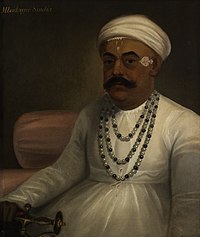This article needs additional citations for verification. (April 2016) |
| Mahadji Shinde | |||||
|---|---|---|---|---|---|
| Meherban Shrimant Sardar Shinde Bahadur Naib Vakil-i-Mutlaq Amir-ul-Umara[1] Maharajah of Gwalior | |||||
 Mahadaji Shinde by James Wales c.1792 | |||||
| Raja of Gwalior | |||||
| Reign | 18 January 1768 — 12 February 1794 | ||||
| Coronation | 18 January 1768 | ||||
| Predecessor | Manaji Rao Shinde | ||||
| Successor | Daulat Rao Shinde | ||||
| Naib Vakil of the Mughal Empire | |||||
| Term | 1784 — 12 February 1794 | ||||
| Emperor | Shah Alam II | ||||
| Predecessor | Madhavrao II | ||||
| Successor | Daulat Rao Shinde | ||||
| Born | 23 December 1730 Ujjain, Gwalior State, Maratha Confederacy (modern-day Madhya Pradesh, India) | ||||
| Died | 12 February 1794 (aged 63) Shinde Chhatri, Pune, Maratha Confederacy (modern-day Maharashtra, India) | ||||
| Spouse |
| ||||
| Issue | Bala Bai Chimna Bai | ||||
| |||||
| House | Shinde | ||||
| Father | Ranoji Rao Shinde | ||||
| Mother | Chima Bai | ||||
| Religion | Hinduism | ||||
| Military career | |||||
| Service/ | |||||
| Rank | Sar-i-Naubat / Senapati Sarnobat Shiledar | ||||
| Unit | Maratha Infantry Maratha Cavalry Maratha Artillery Pindaris (irregular) | ||||
| Battles/wars | See list
| ||||
| Signature | |||||
Mahadaji Shinde (23 December 1730 – 12 February 1794), later known as Mahadji Scindia or Madhava Rao Scindia,[2] was a Maratha statesman and general who served as the Raja of Gwalior from 1768 to 1794. He was the fifth and the youngest son of Ranoji Rao Scindia, the founder of the Scindia dynasty. He is reputed for having restored the Maratha rule over North India and for modernizing his army.[3]
Mahadji was instrumental in resurrecting Maratha power in North India after the Third Battle of Panipat in 1761, and rose to become a trusted lieutenant of the Peshwa, leader of the Maratha Confederacy . Along with Madhavrao I and Nana Fadnavis, he was one of the three pillars of Maratha Resurrection. During his reign, Gwalior became the leading state in the Maratha Confederacy and one of the foremost military powers in India. After accompanying Shah Alam II to Delhi in 1771, he restored the Mughal Empire in Delhi and became the Naib Vakil-i-Mutlaq (Deputy Regent of the Empire).[4] Mahadji Shinde's principal advisors were all Shenvis.[5]
Mahadji Shinde Fought about 50 Battles In His Lifetime against various opponents. He defeated the Jats of Mathura and during 1772-73 Pashtun Rohillas in Rohilkhand and captured Najibabad. His role during the First Anglo-Maratha War was greatest from the Maratha side since he defeated the British in the Battle of Wadgaon which resulted in the Treaty of Wadgaon[6] and then again in Central India, single handed, which resulted in the Treaty of Salbai in 1782, where he mediated between the Peshwa and the British.
- ^ Page 334, A Comprehensive History of Medieval India: Twelfth to the Mid-Eighteenth Century, By Salma Ahmed Farooqui, Publisher: Pearson Education India, 2011, ISBN 8131732029
- ^ The title of his 1905 biography in the Rulers of India series - Wikisource transcription project
- ^ Rathod, NG (1994). The Great Maratha (1 ed.). Sarup & Sons. ISBN 9788185431529.
- '^ Vakil-i-Mutlaq (Regent of the Empire)
- ^ Rathod, N. G. (1994). The Great Maratha Mahadaji Shinde - N. G. Rathod - Google Books. Sarup & Sons. ISBN 9788185431529. Retrieved 21 July 2012.
- ^ Athale, Colonel Anil A (12 January 2018). "How a Maratha general defeated the British". Rediff News.